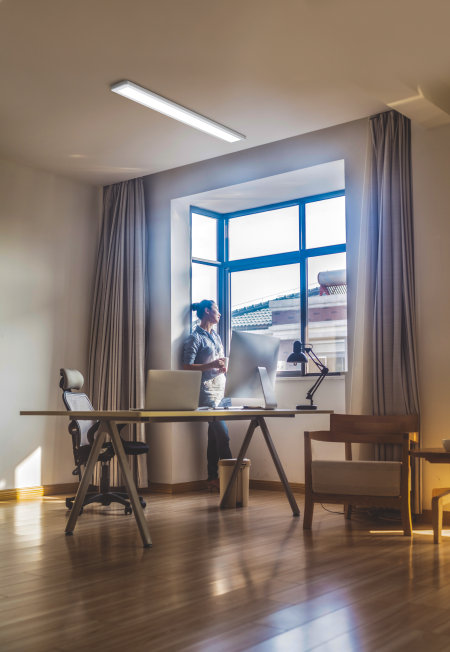There is more to successfully working from home than having a desk and a laptop. With a well thought-out LED lighting plan, you can make your home office a comfortable space. You can even increase your concentration, as the right light makes you more alert and more efficient. And thanks to clever LED technology, you can reduce your electricity bills too. What are you waiting for? Be focused when working from home by developing your own lighting plan today.
 THE RIGHT LIGHT LEVEL
THE RIGHT LIGHT LEVELNot too bright, not too dull – what level of illumination is ideal for office lighting in a study? The European standard DIN EN 12464-1 gives practical guidance on the lighting of indoor workspaces. These are the most important illumination parameters:
The last two parameters apply mainly to office lighting in large spaces and facilities. However, the first two points are important for your home office. To achieve office lighting of 300 lux, an LED lamp should be at least 600 lumens. You can achieve 500 lux for your workspace with a 1,000 lumen desk light. By comparison, a bright, sunny day outdoors is up to 100,000 lux.
To ensure the lamp on your desk is as effective as possible, you should choose your desk lamp carefully. An angle poise lamp is ideal, as you can reposition the lamp over and over again (for example, if you have a problem with the printer on a side table, or are regularly referring to a book next to the laptop). If your desk does not provide enough room for a good desk lamp, you can choose a clamp lamp which you can attach to a shelf above the desk.

1. Which colour temperature is the best choice for my study?
Colour temperature is measured in Kelvin:
Lighting for a study or home office should be at least 4,000 Kelvin. Bright light with a high blue content keeps you alert, active and supports your concentration.
2. What type of lights should I use for a study?
Modern LED lights are low-energy and long-lasting. The constant calm, flicker-free light has a beneficial effect on your eyes. With the additional warm-dim function, you can easily adjust the colour temperature when needed to adapt to lighting conditions outside.
 BE CREATIVE!
BE CREATIVE!When first creating your home office, you should consider optimal lighting for the workspace with a mix of daylight, direct and indirect lighting:
With even highlights, you can create a cosy place to work. Design your personalised LED home office lighting now!